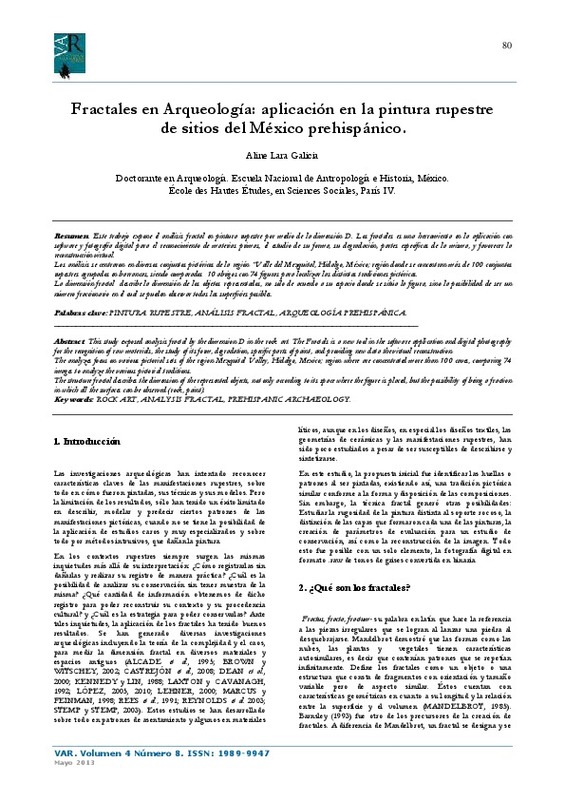JavaScript is disabled for your browser. Some features of this site may not work without it.
Buscar en RiuNet
Listar
Mi cuenta
Estadísticas
Ayuda RiuNet
Admin. UPV
Fractales en Arqueología: aplicación en la pintura rupestre de sitios del México prehispánico
Mostrar el registro sencillo del ítem
Ficheros en el ítem
| dc.contributor.author | Lara Galicia, Aline
|
es_ES |
| dc.coverage.spatial | east=-102.552784; north=23.634501; name=Mèxic | es_ES |
| dc.date.accessioned | 2020-03-12T10:21:14Z | |
| dc.date.available | 2020-03-12T10:21:14Z | |
| dc.date.issued | 2015-05-20 | |
| dc.identifier.uri | http://hdl.handle.net/10251/138776 | |
| dc.description.abstract | [ES] Este trabajo expone el análisis fractal en pintura rupestre por medio de la dimensión D. Los fractales es una herramienta en la aplicación consoftware y fotografía digital para el reconocimiento de materias primas, el estudio de su forma, su degradación, partes específicas de la misma, y favorecer la reconstrucción virtual.Los análisis se centraron en diversos conjuntos pictóricos de la región “Valle del Mezquital, Hidalgo, México; región donde se concentran más de 100 conjuntos rupestres agrupados en barrancas, siendo comparados 10 abrigos con 74 figuras para localizar las distintas tradiciones pictóricas. La dimensión fractal describe la dimensión de los objetos representados, no sólo de acuerdo a su espacio donde se sitúa la figura, sino la posibilidad de ser un número fraccionario en el cual se pueden observar todas las superficies posibles. | es_ES |
| dc.description.abstract | [EN] This study exposed analysis fractal by the dimension D in the rock art. The Fractals is a new tool in the software application and digital photographyfor the recognition of raw materials, the study of its form, degradation, specific parts of paint, and providing new data the virtual reconstruction.The analyzes focus on various pictorial sets of the region Mezquital Valley, Hidalgo, Mexico; region where are concentrated more than 100 caves, comparing 74 images to analyze the various pictorial traditions.The structure fractal describes the dimension of the represented objects, not only according to its space where the figure is placed, but the possibility of being a fraction in which all the surfaces can be observed (rock, paint). | es_ES |
| dc.language | Español | es_ES |
| dc.publisher | Universitat Politècnica de València | es_ES |
| dc.relation.ispartof | Virtual Archaeology Review | es_ES |
| dc.rights | Reconocimiento - No comercial - Sin obra derivada (by-nc-nd) | es_ES |
| dc.subject | Rock art | es_ES |
| dc.subject | Analysis fractal | es_ES |
| dc.subject | Prehispanic archaeology | es_ES |
| dc.subject | Pintura rupestre | es_ES |
| dc.subject | Análisis fractal | es_ES |
| dc.subject | Arqueología prehispánica | es_ES |
| dc.title | Fractales en Arqueología: aplicación en la pintura rupestre de sitios del México prehispánico | es_ES |
| dc.type | Artículo | es_ES |
| dc.identifier.doi | 10.4995/var.2013.4323 | |
| dc.rights.accessRights | Abierto | es_ES |
| dc.description.bibliographicCitation | Lara Galicia, A. (2015). Fractales en Arqueología: aplicación en la pintura rupestre de sitios del México prehispánico. Virtual Archaeology Review. 4(8):80-84. https://doi.org/10.4995/var.2013.4323 | es_ES |
| dc.description.accrualMethod | OJS | es_ES |
| dc.relation.publisherversion | https://doi.org/10.4995/var.2013.4323 | es_ES |
| dc.description.upvformatpinicio | 80 | es_ES |
| dc.description.upvformatpfin | 84 | es_ES |
| dc.type.version | info:eu-repo/semantics/publishedVersion | es_ES |
| dc.description.volume | 4 | es_ES |
| dc.description.issue | 8 | es_ES |
| dc.identifier.eissn | 1989-9947 | |
| dc.relation.pasarela | OJS\4323 | es_ES |
| dc.description.references | RODRÍGUEZ, A., ALONSO, C. & VELÁZQUEZ J. (1995): "Fractales para la arqueología: un nuevo lenguaje", Trabajos de prehistoria, vol. 52, nº 1, pp. 13-24. | es_ES |
| dc.description.references | BROWN, Clifford et al. (2002): "The fractal geometry of ancient maya settlement." Journal of archaeological science, nº 30. Estados Unidos, pp. 1619-1632. | es_ES |
| dc.description.references | DEAN Jeffrey, et al. (2000): "Understanding anasazi culture through agent-based modeling" ,Dynamics in human and primate societies, Timothy Kohler y George Gumerman (compiladores), Oxford, Oxford University Press, pp. 179-205. | es_ES |
| dc.description.references | KENNEDY, Stephen & LIN, Wei- Hsiung (1988): "A fractal technique for the classification of projectile point shapes", Estados Unidos, Geoarchaeology, nº 3, vol. 4, pp. 297-301. | es_ES |
| dc.description.references | LARA, Aline (2010): "Estado del arte en las manifestaciones rupestres del Valle del Mezquital", PEH, NMAM, AE H, pp.145-173. | es_ES |
| dc.description.references | LARA, Aline (2012): Las firmas fractales en las manifestaciones rupestres del Valle del Mezquital, México, Tesis de doctorado, Escuela Nacional de Antropología e Historia. | es_ES |
| dc.description.references | LAXTON, R. R. & CAVANAGH W. G. (1992): "The Rank-Size Dimension and the History of Site Structure from Survey Data", en Journal of quantitative anthropology, vol. 5, pp. 327-358. | es_ES |
| dc.description.references | MANDELBROT, Benoit B (1985): "Self-Affine Fractals and Fractal Dimension", en Physica Scripta, vol. 32, nº 4. | es_ES |
| dc.description.references | MARCUS Joyce y FEINMAN Gary (1998): "Introduction", Archaic states, Gary Feinman y Joyce Marcus (eds.), Estados Unidos, pp. 3-13. | es_ES |
| dc.description.references | PARROT François (2009): Fractal researches on geosciences, México, UNAM. | es_ES |
| dc.description.references | REES Anna, et al. (1991): "An investigation of the fractal properties of flint microwear images", Journal of archaeological science, v. 18, pp. 629-640. http://dx.doi.org/10.1016/0305-4403(91)90026-L | es_ES |
| dc.description.references | REYNOLDS, Robert et al. (2003): "The effects of generalized reciprocal exchange on the resilience of social networks: An example from the prehispanic mesa verde region". Computational & mathematical organization theory, nº 9, pp. 227-254. http://dx.doi.org/10.1023/B:CMOT.0000026583.03782.60 | es_ES |
| dc.description.references | SCHLOEN, David (2001): The house of the father as fact and symbol: patrimonialism in ugarit and the ancient near east, Studies in the archaeology and history of the Levant 2, Eisenbrauns, pp. 414. | es_ES |
| dc.description.references | STEMP James y Michael Stemp (2003): "Documenting stages of polish development on experimental stone tools: surface characterization by fractal geometry using UBM laser profilometry", Journal of archaeological science, vol. 30, Academic Press, pp. 287-296. | es_ES |








